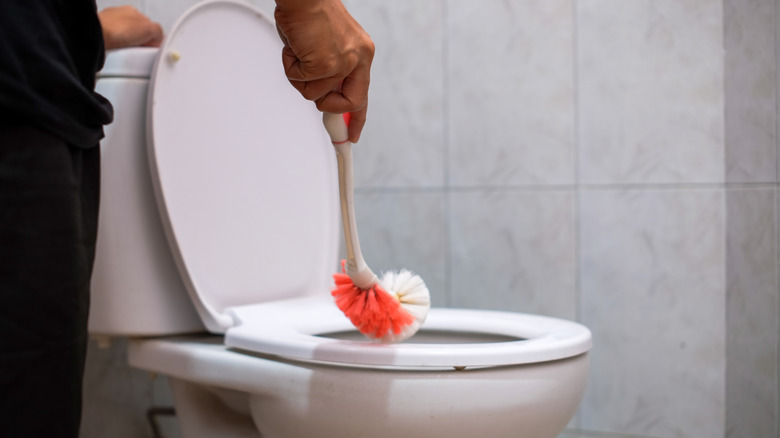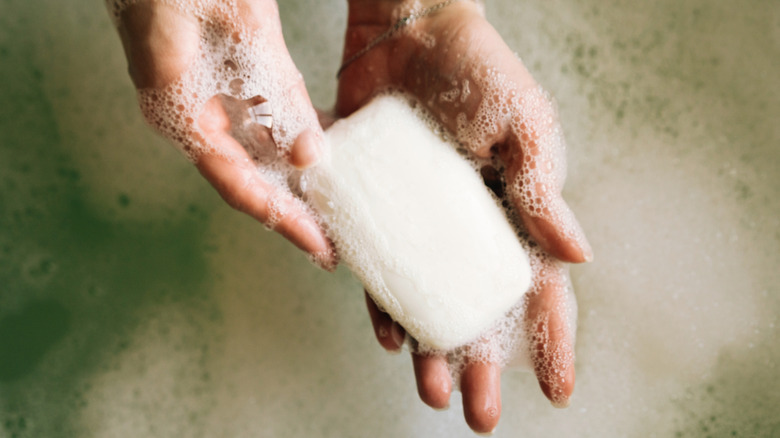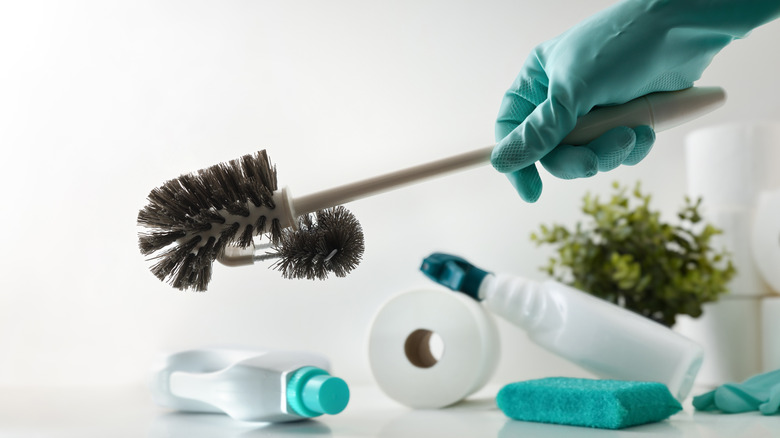Can A Bar Of Soap Really Help With Toilet Odors? Here's What You Need To Know
We may receive a commission on purchases made from links.
Dealing with toilet odors is a universal struggle, which might explain why the internet is always full of quirky deodorizing tricks. One of the latest trends blowing up on TikTok involves dropping a bar of soap into your toilet tank. It's part of a larger social media movement towards simple, DIY cleaning hacks, many of which make use of basic household items in unexpected ways. From dryer sheets in air vents to spritzes of vinegar on grout, these trends offer a fast fix — but not all of them are as harmless or as helpful as they may appear. The bar of soap trick claims to keep your toilet bowl smelling fresh and your bathroom clean with minimal effort. But does it actually work, or could it be doing more harm than good?
The idea is to unwrap a bar of strongly smelling soap — some recommend slicing it into chunks — and dropping it directly into your toilet tank. Other tricks include cutting open a face mask and hanging the soap in the water, as an attempt to avoid the chunks sitting in the bottom of your toilet tank. Then, as your toilet refills after every flush, the soapy water filters into the bowl, supposedly cleaning and freshening at the same time. It's certainly an interesting trick for odor control, especially renters or homeowners who are looking to avoid harsh chemical solutions. Still, just because it's currently trending doesn't mean it's a smart choice. Plumbing experts are raising red flags about the long-term impact of this trick, and your toilet tank might not be the best place for your favorite bar of soap. So is it a brilliant cleaning hack or just another internet gimmick that may cause some serious damage to your home?
Potential problems with putting soap in your toilet
Though the soap in the tank hack might seem like a cheap and easy way to clean your toilet tank, it can actually lead to some serious plumbing headaches. For starters, your toilet's tank is a finely tuned mechanism that's designed to flush water — not oils, not chemicals, and definitely not melting bars of soap. As the soap breaks down over time, it creates a film or residue that can coat the moving parts inside your tank. Think of the flapper, fill valve, and float; all of which are essential parts that need to stay clean and move freely in order for your toilet to flush correctly. Once the parts get gummed up by a waxy, soapy coating, your flush might feel weakened, incomplete, or even non-functional. Suddenly, your cheap, quick-fix deodorizer turns into a repair bill.
And if you're one of the millions of Americans using a septic system, the risks only increase. Septic systems rely on a careful balance of bacteria to break down waste effectively, and many soaps — especially those with synthetic fragrances or antibacterial properties — can disrupt that balance. Over time, the buildup from the soap can clog up your system or lead to reduced efficiency, requiring costly plumbing or repairs. Even if you're on a city sewer system, dissolved soap still travels down the pipes to get there, meaning it can contribute to buildup or interact poorly with other household cleaners. Plus, there's always a chance that the soap dislodges from its mesh bag and clogs your refill mechanism all together. In short, while soap is considered a bathroom staple, it should never find its way into the tank of your toilet, as it can lead to some serious complications for your home.
Other options instead of using soap
If you're aiming for a better-smelling bathroom, there are plenty of toilet-safe alternatives that won't jeopardize your plumbing. One option is to use in-bowl toilet cleaning tablets, like Scrubbing Bubbles Toilet Bowl Tablets, that are specifically designed for deodorizing and disinfecting. These are meant to slowly and safely dissolve without harming internal components. Another simple trick is to keep a small bowl of baking soda in the bathroom to naturally absorb smells in tighter spaces of your home. Essential oil diffusers and charcoal bags are also solid, safe alternatives that neutralize smells without introducing risky chemicals to your tank.
For those who like the idea of using a simple bar of soap, try incorporating it into your regular toilet cleaning routine instead. A few swipes with a soapy sponge around the bowl or under the rim can go a long way in keeping odors at bay. You can also dissolve grated soap in warm water and spray it on the seat or the outside of the tank to introduce that fresh, soapy smell without sacrificing the security of your plumbing system. If you're interested in using an alternative cleaner, you can opt for baking soda in your toilet, as it is much safer on plumbing. When it comes to cleaning your toilet, soap is definitely still an option, but it should never go into your plumbing. These creative methods let you enjoy the scent and disinfecting power of using soap without putting your toilet's internal components at risk.


